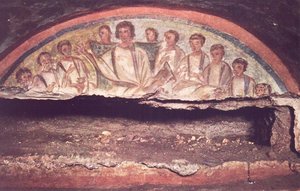EARLY CHRISTIAN PERIOD

Early Christian art in the eastern part of the Roman Empire is usually considered to be part of Byzantine art. The Christian religion was part of a general trend in the late Roman Empire toward mysticism and spirituality. As Christianity developed, its art reflected the prevailing late antique artistic climate. Except for differences in subject matter, Christian and pagan works looked much the same; in fact, it is possible to show that the same workshop sometimes produced sculpture for both Christian and non-Christian purposes.
The earliest Christian art consists of a few 2nd-century wall and ceiling paintings in the Roman catacombs (underground burial chambers), which continued to be decorated in a sketchy style derived from Roman impressionism through the 4th century. They provide an important record of some aspects of the development of Christian subject matter. The earliest Christian iconography tended to be symbolic. A simple rendering of a fish was sufficient to allude to Christ. Bread and wine invoked the Eucharist. During the 3rd and 4th centuries, in the catacomb paintings and in other manifestations, Christians began to adapt familiar pagan prototypes to new meanings. The early figural representations of Christ, for instance, most often show him as the good shepherd by directly borrowing from a classical prototype. He was also sometimes depicted in the guise of familiar gods or heroes, such as Apollo or Orpheus. Only later, when the religion itself had achieved some measure of earthly power, did he take on more exalted attributes. Narratives tended at first to be typological, often suggesting parallels between the Old and New Testaments. The earliest scenes from the life of Christ to be depicted were the miracles. The Passion, particularly the Crucifixion itself, was generally avoided until the religion was well established.
The beginnings of Early Christian art date to the period when the religion was yet a modest and sometimes persecuted sect, and its flowering was possible only after 313, when the Christian emperor Constantine the Great decreed official toleration of Christianity. Subsequent imperial sponsorship brought the religion popularity, riches, and many converts from all classes of society. Suddenly the church needed to produce art and architecture on a more ambitious scale in order to accommodate and educate its new members and to reflect its new dignity and social importance.
DEAR GRADE 10's
Please refer to your Booklets and define the following in full sentences:
- Martyr
- The crusades
- The Chi-Rho monograph
- Iconography
- Sarcophagus
- Tesserae
Total- 12 marks
Due next lesson